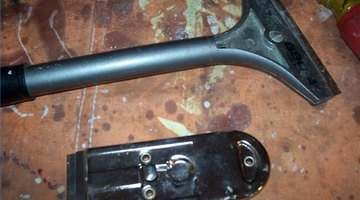Removing Wall Tile Glue
You'll make an awful mess, no matter what you try. Mastic and other tile adhesives are formulated to stick, not fall off the wall. You'll also end up with some wall repairs. Cover the area with a drop cloth, and mask or cover any wallpaper or painted areas not scheduled for redecorating.

Accept the Inevitable

Dig out grout using a grout tool or "Dremel" grinder before pulling tile. This will break the plane of the tile and give you more places to dig under tiles. Use a flat chisel, screwdriver or putty knife and hammer to tap under edges until the tile is down. Pull the tile off the wall as carefully as possible to save the tile and try to get as much adhesive as possible to come off with the tile. Tap and knock any remaining adhesive to crack it gently.
To Scrape or Soak--That is the Question

Scrape as much adhesive off as possible, using a big blade scraper (the ones with the long handles and 4-inch blades) and also using a hammer to gently tap along as you go. Keep at it slowly and systematically to minimize the damage done to the underlying wall. If the wall is cement or brick (why would anybody cover a brick wall with tile?), some old adhesives may succumb to a good soaking with water, citrus cleaner-stripper or diluted muriatic acid (commonly used to clean concrete). On wallboard, use steam wallpaper strippers to soak the area under the adhesive, then scrape carefully. There is no easy way to the job. Careful scraping will probably be the way to get most of the adhesive off, whether it's gummy or hard as a rock. Just be careful to take as little wallboard or underlayment with you as possible.
Follow-Up

Repairing the wreckage also requires skill and patience. With cement or cement board walls, remnants of adhesive can be sanded off--but if you've been digging away at wallboard, you've probably created some craters, holes and abrasions. Sand the leftover adhesive and patch any deep gouges with drywall tape and repair compound (also called "mud"). Small holes can be filled with spackle before taping and mudding. If the surface is all that's damaged, re-mud the wall or cover it with "sizing paper," a wall covering that's used to protect wallboard from wallpaper adhesive. If you've done enough damage to the wall to require more skill than luck with the mudding knife, replace the wallboard by cutting out the damaged section and replacing with a new piece cut to size. However you do the repairs, finish with a light sanding of the entire surface ( a circular sander makes this job easier) with a medium-grit sandpaper to level the mud and finish off any last "peaks" of adhesive. Seal and prime your work before tiling, painting or wallpapering.
The Drip Cap
- You'll make an awful mess, no matter what you try.
- some old adhesives may succumb to a good soaking with water, citrus cleaner-stripper or diluted muriatic acid (commonly used to clean concrete).
- There is no easy way to the job.
- Careful scraping will probably be the way to get most of the adhesive off, whether it's gummy or hard as a rock.
- Repairing the wreckage also requires skill and patience.
- If you've done enough damage to the wall to require more skill than luck with the mudding knife, replace the wallboard by cutting out the damaged section and replacing with a new piece cut to size.
Resources
Writer Bio
An avid perennial gardener and old house owner, Laura Reynolds has had careers in teaching and juvenile justice. A retired municipal judgem Reynolds holds a degree in communications from Northern Illinois University. Her six children and stepchildren served as subjects of editorials during her tenure as a local newspaper editor.
Photo Credits
- DRW & Associates Inc, Microsoft Office clip art
- DRW & Associates Inc, Microsoft Office clip art
More Articles



